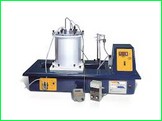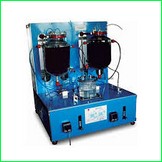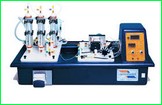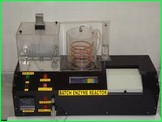| Hari Scientific-1309 Aerobic Digester
Aerobic Digester
consists of a 2 gallon reactor vessel mounted on a steel base, with a liquid feed pump, air supply, and instrumentation for monitoring and controlling the process.
The cylindrical wall of the reactor is made from 2 layers of porous plastic material to retain the suspended solids, while allowing treated water to pass through to the outer, annular exit chamber.
This design allows the essential features of the aerobic treatment process to be studied without the distractions of having to settle the solids adequately enough for external recycle, a well known laboratory problem.
The porous liners are removable for cleaning, and a spare liner is supplied.
Waste water is drawn from a feed tank by a 120V motor driven peristaltic pump. Flow rate is controlled by a variabe run time control that determines the minutes of run time within a 10 minute cycle.
The pump delivers the feed to the reactor vessel through a transparent lid. Air is supplied at a measured rate by a small air pump, and discharges into the base of the reactor via an air distribution device.
This provides the necessary oxygen for the digestion process, as well as produces sufficient bubbling for stirring and reaction.
The liquid level in the reactor is maintained at a constant value of 1 or 2 gal. by an overflow device connected to the outer annular chamber of the vessel. Discharge is by gravity to a floor-standing product tank (not supplied).
The reactor temperature is maintained by a 3-term PID controller which varies power to an immersion heater within the vessel. Any temperature between ambient and 95°F may be selected, with the best conditions being a few degrees above the diurnal maximum in the user’s laboratory.
Dissolved oxygen and pH probes and meters are included.
The reactor lid contains a gas exit port, suitable for sampling the gases for subsequent analysis
Specifications :
Feed pump
120V, peristaltic, 10 rpm, variable run time
control corresponding to 0–13 gal. per day
Air pump
240V/120V, 0–1.35 gpm
Reactor vessel
2 gal. maxium capacity
pH meter
Range 0.00 to 14.00
Dissolved oxygen meter
Range 0–100% saturation, resolution 2%
Reactor heate
Electrical immersion 250W
Temperature controller
3-term PID, temperature limit set at 95°F |




